Copyright ©2010
PopEntertainment.com. All rights reserved.
Posted:
August 31, 2010.
When Melissa Anderson
won the role of Mary Ingalls on the NBC-TV series Little House on the
Prairie (beating out two hundred other child actresses), she was
asked to lose five pounds and sign a seven-year contract.
The good news:
Anderson hit the big time. The heartwarming family show would become a
monster hit for its entire run, from 1974 to 1983. In subsequent years,
reruns and DVDs would mint the series as a pop culture staple for the
Seventies generation and the unborn yet to come.
The irony is clear:
spoiled modern kids who watch the show are transported to the 1870s,
where they chill with an unspoiled family representin’ the American
prairie. The episodes are laden with happiness and tears, but not a
single luxury. The after-school-special pleasure of each life lesson is
not lost on its legions of fans: family first, work hard, be kind to
animals and others, attend church, keep your barn clean, stand up to
Nellie, and don’t fall asleep with the lantern burning.
The bad news:
Melissa’s character, Mary Ingalls, would be put through her melodramatic
paces. America tuned in, week after week, to see just how much big
trouble one little girl could handle.
Mary suffered the
very lowest depths of tragedy and indignity, with permanent blindness
tacked on at no extra charge. Anderson, as a result, was a miracle
worker, accepting every challenge the writers could throw at her: fire,
water, rabid raccoons, unaffordable Christmas gifts, an unattainable
leather-bound dictionary, snotty classmates, shifty drifters and every
classification of nature unleashing her savage fury. But wait, there’s
more!
The series may have
centered around the younger sister, Laura (commonly known as Half Pint
and played by the other Melissa, Melissa Gilbert), but Anderson’s is the
character we remember. Her tribulations would make even Job look up to
heaven and say, “Enough! Enough! What are You doing?”
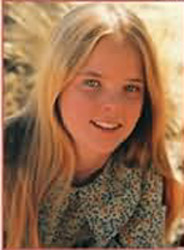 In
seven years, Mary from the Prairie became TV’s reigning Queen of
Pain. Nice work if you can get it. As a result, she was the only cast
member to be nominated for (and win) an Emmy.
In
seven years, Mary from the Prairie became TV’s reigning Queen of
Pain. Nice work if you can get it. As a result, she was the only cast
member to be nominated for (and win) an Emmy.
“I’m lucky that there
even was a character to play, because in the book, there isn’t much of
one,” she tells me from her home in Montreal. “Laura [Ingalls, author
of the Little House novels upon which the series was based and
the story was centered] was a quite older woman when she wrote the
books. She was remembering the best of her life. The characters of Ma
and Mary didn’t factor in a lot. There was a lot of Laura and Pa and
Laura and Jack the dog and Laura and Mr. Edwards, but there wasn’t a lot
of Mary. I’m fortunate that they discovered that I could act.”
Her talents being
appreciated came about as a result of a classic TV Catch-22.
She says, “I couldn’t
show [the writers] what I could do unless they wrote me something to do.
And they weren’t going to write me something to do until I showed them
what I could do. Eventually, I was able to prove myself in the first
year, and then I got some really great meaty episodes.”
Meaty, that’s for
damn sure. She stirs that prairie stew in her new memoir, The Way
I See It: A Look Back at My Life on Little House (Globe Pequot
Press). The book covers her season-by-season experiences on the show
from its unlikely premiere in 1974 to her weary but victorious departure
in 1981.
The book is a
tell-all, but the tell is not totally all.
“I wanted to be able
to tell my story, but not in the way so many other memoirs seem to be,”
she says. “[Other memoirs] are sometimes very mean and there is always a
villain somehow. I wanted to show that the experience that I had was
quite good. I wanted it to be honest; it’s not a completely rosy
picture, but nothing terrible has happened to me and I don’t blame
anybody for anything. That was really important to me, and my publisher
was good about that. They agreed with me. It’s a truthful but not
hurtful story.”
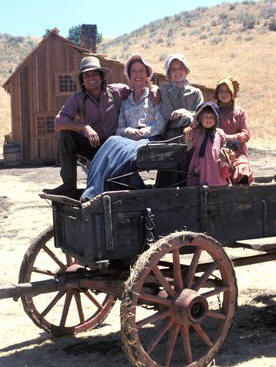 Despite
the fact that she was a child star, Anderson could not be shoe-horned
into the usual unhappy ending that had befallen so many other TV actors
of that era.
Despite
the fact that she was a child star, Anderson could not be shoe-horned
into the usual unhappy ending that had befallen so many other TV actors
of that era.
“I was raised well as
a kid,” she says. “A lot of people ask me, ‘How come you didn’t get into
trouble?’ Frankly, I was just too afraid. I didn’t want to get into
trouble. I was afraid of the consequences. And I was a good kid
overall.”
However, there was
one single regret.
She says, “The one
thing that was missing from my childhood, the one thing that I didn’t
focus on enough as a child, was a regular life, having a regular
childhood. However, I loved what I had. I loved working professionally.
I wanted it to be my career so that life was fantastic. But when I
became an adult, I strived for ‘regular.’ That’s what I wanted. I wanted
to make sure that I was treated however I was for me and not for what
people perceived me to be. That’s what is kind of nice about the book. I
think people can read the book and know me.
“A lot of child
actors go through this and it’s hard to balance. I had a pretty normal
life, but you never know if people are your friends for the right
reasons. When I had my own kids, I was out of the business, removed; I
only worked occasionally so that my kids could have a really normal
upbringing. I certainly didn’t want them to become actors, and I know
that they’re not going to be. You want something a little more stable
for your children. It’s nice for me to have kids and live a regular kind
of life through them.”
These days, she lives
a peaceful existence as an ex-pat in Montreal. Married to TV producer
and screenwriter Michael Sloan, and with two children still in the
house, she is living the dream of the “regular.”
Born and raised in
California, she had been working as an actress since she was nine. Her
big break came with Little House, but a prior one-time appearance
on The Brady Bunch set her forever in pop culture stone. She
guest-starred as Millicent, the first girl to kiss Bobby Brady. However,
like the prepubescent Bobby, she herself saw skyrockets happen when her
own series took off and the covered wagon started to move.
“By the beginning of
the second season, we were recognized all the time,” she says. “I knew
I wasn’t going to have a regular life then. I did have to learn how to
always be good to the fans, even though as a kid, it’s awkward. It’s
awkward as an adult too. Fans mean well. You mean well. You’re walking
along and sometimes people stop and stare and point. It’s easier if they
just come up to you and get it over with and talk. As a kid, it was
magnified. It was a little harder. But you get good at it. I also got
good at walking and looking straight ahead. Not looking around and
slowly walking. You need a direction and you’re focused on it and you
go, and people don’t notice you as much.”
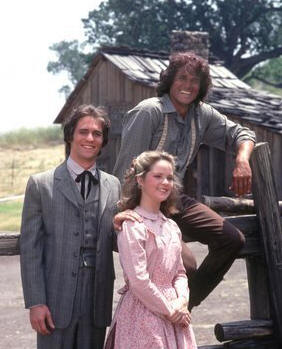 With
the adjustment to celebrity, she was often misunderstood.
With
the adjustment to celebrity, she was often misunderstood.
“People thought I was
aloof,” she says, “but I was really just shy. I was serious about what I
did. I wanted to do a great job.”
One of the people who
had no doubts about her ability was the late actor/producer Michael
Landon, who was already a huge television star when he put the series
together and played her TV Pa.
“I was friends with
him and worked with him up to the year before he died,” she says. “He
came to my wedding. He got sick right after I had my daughter. All those
years I was close to him.”
However, even
father-daughter relationships on television mirror reality. Anderson was
shaken when it was revealed that the married Landon was having an
affair.
“He went in and out
of favor with me occasionally,” she says. “When you hold someone in such
high esteem, you can’t believe it when they fall. And I don’t think I
was the only one. But it taught me a great lesson very early on that I
had to work with him every day, no matter what. He was my boss and I did
love him. He was a great guy and a great person in my life, like a big
brother to me. So I had to get over it and move on. I had to accept it
as part of life. He’s not perfect, and he never said that he was. When I
was writing about this in the book, the Tiger Woods thing was happening.
And I thought, Mike Landon was nothing like Tiger Woods. We all build
them up, even me. He was big in our minds.”
Anderson credits the
success of the show to the determination and vision of Michael Landon.
She says, “Every
little girl growing up certainly reads and loves those Little House
books. They’re simple. It’s longing for that simple life, simple but so
difficult too. Look at how hard it was! But we had the added plus of
Mike Landon.
“People ask me all
the time if I think the show would be a hit now, and I think no. The
audience is too sophisticated now in the sense that the stories would
move too slowly. To air a show like ours, it has to be at a slower pace.
“I don’t know if
people want to invest in something that’s slower now when you’re so used
to everything being fast. And without Mike Landon, it wouldn’t happen.
The whole reason that Little House sold as a pilot and went to a
series was because of him. It certainly wasn’t the rest of us. I mean,
we were all fine, but he was a huge star with great charisma. Recently
they tried to redo that new Little House show and it didn’t work
out.”
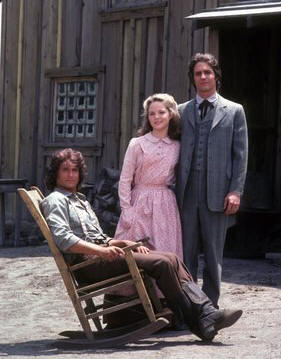 Surprisingly
as well is the relationship (or lack thereof) of Anderson and her TV
sister, Melissa Gilbert. They did not exactly stay in touch.
Surprisingly
as well is the relationship (or lack thereof) of Anderson and her TV
sister, Melissa Gilbert. They did not exactly stay in touch.
“We were so
different,” she says. “That happens so often on series television, when
you are literally thrown together. Sometimes you might have something in
common with somebody, or a lot of things in common, but most times you
don’t. We were pretty good at what we do, I guess, because we were such
a great family on screen, but we really didn’t have anything in common.
We never fought. We always got along. But we just never had anything in
common. We’ve never really been close.”
Still, they had us
believing. And more so, Anderson had us believing that she was blind, to
the point where fans still believe to this day that perhaps the actor
and not the character had lost her vision.
“Mary went blind in
the book,” she says. “When the pilot sold and we were going to series,
[the “Mary going blind” plot point] was always in the back of my mind,
but I thought, no, they won’t do that to me. And then I started hearing
rumblings about it in the third season and I thought, ‘oh, this is
terrible! They are going to write me out. If the character goes blind,
that will be it. What am I going to do?’ And I was miserable.
“I finally got the
courage up to talk to Mike Landon at our wrap party. And he said, ‘Trust
me. It’s going to be great.’ And he was right. It was great, for a
while, certainly for the first year and maybe most of the second year.
But after that it was a little limiting.”
Though expertly
played, the blind sister thing got a little old; besides, Anderson had
visions of other projects. She was already starring in afterschool
specials and prime-time TV movies, as well as her share of Love Boat’s
and Fantasy Island’s.
“I fulfilled my
seven-year contract,” she says of her final departure from Little
House. “I did two episodes during the eighth season, but I couldn’t
take it anymore – I couldn’t take another tragedy. I was just there for
audience recognition, so they know I didn’t die. It was either feast or
famine. Either I was involved in some horrible tragedy, or nothing. And
the blind thing was just too limiting. So I bid farewell. It was fine.
It was an easy, gradual way out.
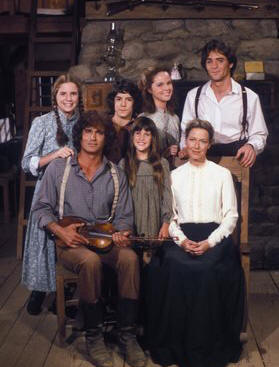 “Actually,
I started out the seventh season doing [the theatrical film] Happy
Birthday to Me in Montreal. And
I was here for eight or nine weeks. I was always working on something
else. Whenever I wasn’t being used on Little House and there was
enough notice, I could do a movie of the week or an after school special
or a Love Boat or this or that. I got really used to not being
there every day, especially in the last year. That was good because it
made it easier to go.”
“Actually,
I started out the seventh season doing [the theatrical film] Happy
Birthday to Me in Montreal. And
I was here for eight or nine weeks. I was always working on something
else. Whenever I wasn’t being used on Little House and there was
enough notice, I could do a movie of the week or an after school special
or a Love Boat or this or that. I got really used to not being
there every day, especially in the last year. That was good because it
made it easier to go.”
One of the proudest
moments of her career came as the result of a guest-starring stint on
the acclaimed CBS series The Equalizer, starting in 1986.
“It was my favorite
job,” she says. “They were so well-written. I’m usually so hard on
myself, but I was really proud of my work here. I was happy with what I
did in those episodes. It elevates your game. You’re going to be
better, because the material and the actors and the material are all so
good. I also loved it because it was shot in New York.”
A far cry from the
Prairie, but her heart is still warm for those open spaces and fond
memories.
“I’m constantly
surprised at its impact,” she says of the series which made her famous.
“It really is surprising to travel around and see all these people who
love the show so much. I don’t know why I’m surprised, but when you’re
part of it, you don’t think about it. I’m very happy to have been a part
of something that’s so special to so many people.”
Features Return to the features page